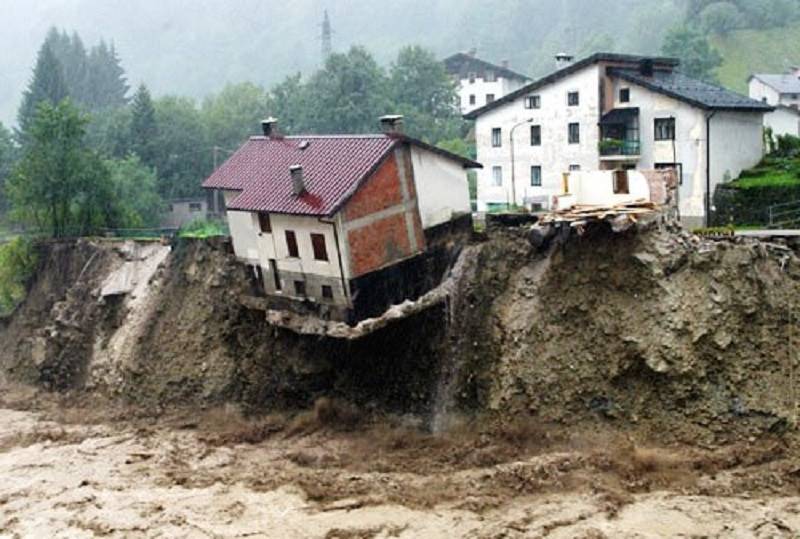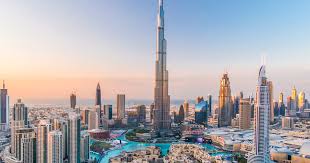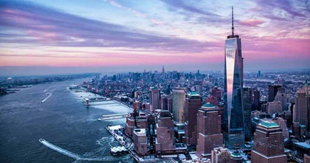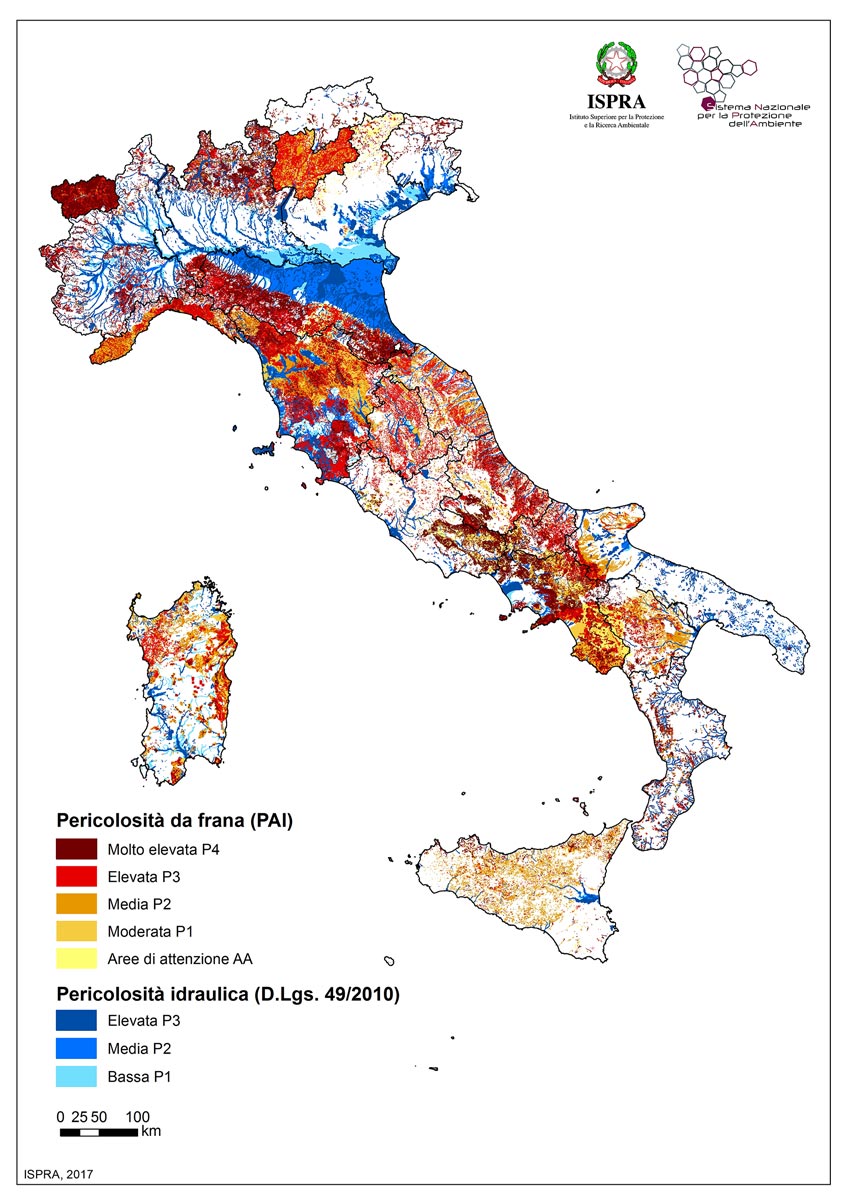
CONTEMPORARY URGENCES
THE CLIMATE CHANGES AND WITH IT THE NEEDS OF THE SOCIETY
The awareness of being part of a complex system, of being a link in the chain is entering the collective consciousness. The link between anthropocene [1] and global warming [2] is evident and has been explained on several occasions by scientists from all over the world. The knowledge of the phenomenon is growing, however it remains a superficial knowledge [3], almost an anecdote that is mentioned on particularly hot days or when you have to chat with the neighbor.
The awareness of the relationships that are generated starting from the phenomenon itself is almost totally absent; the increase in global temperatures is the cause of upheavals in our environment such as: the increase in catastrophic events, both for violence and for number [4]; the growth of migratory phenomena and the increasingly evident fragility of the territory, especially the urbanized one, which suffers violent atmospheric agents.
The community tends to rely on the information that comes from the most disparate and not always scientifically reliable sources, to the extend of being in difficulty in logically analyzing the processes of simple cause and effect, which today are widely documented, but which in the past were simply the result of an empirical analysis; as the observation of phenomena as they appear.

The climate is constantly changing; the climatic cycles, divided into Ages and Periods, have always alternated between warmer and colder periods, even in human history, this is witnessed firstly by the various migrations and then by documents and studies of climatology. Popular culture has been perfectly able to adapt and learn about its habitat, the relationship between man and nature has always been based on a solid and respectful connection.
This form of relationship had its collapse with the advent of the industrial revolution, technological-industrial progress has given the illusion to the man to be able to control also those physical processes that he did not know. We have produced, consumed and issued too much [5]; The climate is changing faster due to human action, but now humans are really in danger, we don’t have the time to adapt.
Our cities are reaching unbearable temperatures, aggressive overbuilding has weakened our soils and dikes and coastal urbanization is starting to be affected by erosion. These are just some of the responsibilities of the design, towards the safety of the population. To date, often, our homes are not only no longer able to protect us, but also they have become part of the problem.
TECHNICAL ARCHITECT OR ARTIST?
Following this premise, the importance of the designer‘s role in this process of hyper-consciousness of the territory and the built environment will be evident. The birth of the architect figure is associated with the birth of the first civilizations, then the architecture and the architect had the primary purpose of protecting the population and its places of sociality, from nature.
This embryonic form of architecture developed into the Vitruvian view that was ultimately followed by modern and contemporary architecture much more closely linked to its creator, which then generated the figure of the great creative artist. The profession over time has been characterized by multiple aspects, of which technique and aesthetics are cornerstones, and this duplicity coexisted harmoniously until the middle of the last century, when the new and dynamic forms of communication brought to light themes that they were often ignored, thus forcing the project community to raise new questions.
The aforementioned issues ranged from social crises to energy crises up to economic ones that inevitably have interference with design at all scales. Despite the strong pressures from the outside world these aspects of the professional figure have gone increasingly to separate due to technological progress, the speed of communications and scientific research. Considering, therefore, the increasingly fashionable and glossy trend that fills research into design innovation, we increasingly ask ourselves what the professional’s boundaries are between ethics [6]: awareness of an emergency and having the responsibility to intervene and aesthetics [7]: beauty, at the service of the project and urban and social regeneration.

THE BALANCE OF THE CONTEMPORARY PROJECT
CONSTRUCTIVE FREEDOMS WITH AESTHETICS / RESEARCH AND DEVELOPMENT FOR ETHICS
Adaptation to climate change that will impact our environment is an issue that architecture has faced sporadically. Never before have we had the tools to predict how our future will change in terms of climate, in fact we know the real environmental impact of the building sector.
The technological progress allows us to have an unlimited constructive freedom, we see equal glass skyscrapers in parts of the world completely different in culture, environment and function, this great freedom has given the illusion of being able to ignore the peculiarities of the sites on which we go to to design. The great developing nations [8] invest and speculate on the symbols of the architecture of Western countries from oil to the skyline to which all the capitals aspire.


At the same time, research, climate and emission emergencies require a violent turnaround. The tendency is that of a return to the principles of vernacular architecture closely linked to the climate and local needs with the addition of control instruments such as LCA, the Circular Economy and renewable resources. This design, in line with research developments aimed at reducing emissions, should be combined with the design of adaptation plans to protect the population from increasingly frequent and violent catastrophic climatic events [9].
However, the design trend is limited to the achievement of the zero Energy Building which, however, is no longer sufficient to protect the environment and consequently the population. On the scale we therefore have aesthetics as the experience of beauty, production and products of art and ethics as a branch of philosophy that deals with the sphere of good or bad actions and not with those legally permitted or prohibited or adequate.
QUESTIONS – ARTIST ARCHITECT IN A CHANGING WORLD
BALANCE SEARCH – ARCHITECT DON CHISCIOTTE 4.0 OR WIND MILL DESIGNER?
The challenge to be proposed to the designer thus becomes the mitigation of the artistic design gesture in favor of a new, more dynamic conception of architecture, capable of accommodating and adapting to the inevitable climate changes. The search for pure aesthetics and formalism are harmful attitudes.
The key word must be: Adaptation [10], we must adapt our cities and our architectures, which are able to change, regenerate themselves and the environment around them [11]. The risk to which we are subjected as designers is that of not being the first to be able to accept change and to think of dynamic and changing systems that not only adapt but take strength from the changes to which we are subjected.
The static nature of thought is the great enemy of the twenty-first century, in which everything changes rapidly to the point of not being able to adapt, and here the great paradox is inserted: The architect has always stood out for his ability to imagine the mutability of the future, urban, technological and social without the scientific means to predict this future; Now that forecasting tools exist, and new solutions need to be found, we seem unprepared. To find new solutions and approaches we must approach scientific / methodological research, which together with design can allow the development of real and effective solutions.
When the theory does not meet the practice, the theory remains written and the practice is fragile. Our architectures must take example from the most elementary infrastructures, such as windmills, which draw strength from the weather. Not accepting this revolution in thinking means becoming Don Chiscotte 4.0 that instead of designing them, fights them.

NOTE:
[1] Term indicating the geological era in which man is present, to whose activities the main causes of territorial, structural and climatic changes are attributed. Definition spread by the biologist Eugene F. Stoermer
[2] For further information, refer to the reports of: The Intergovernmental Panel on Climate Change (IPCC).
[3] Reading of: The great Blindness by Amitav Ghosh is recommended.
[4] Statistics on increasing natural disasters https://natcatservice.munichre.com/
[5] Please refer to the volume “From the cave to the ecological house” F. Butera.
[6] Derived from the Greek it refers to the doctrine of philosophy that questions man’s behavior by assigning him a deontological staus, coming to distinguish between good and evil.
[7] It derives from the Greek, refers to a branch of philosophy that deals with the knowledge of beauty, artificial and natural.
[8] The recent Conferences of the Parties (COP24) and conferences on the climate have brought to light the contrasts and the difficulties of the developing countries in adopting decarbonisation practices, and the use of renewable energies, since oil is still more economic and profitable for economic and social growth.
[9] The Green Building Council and the RIBA are among the most important research and development Networks for decarbonisation and adaptation plans. See for example: Climate Change toolkit 07 design for flood risk.
[10] Consultation of the Legambiente city-climate observatory is recommended.
[11] Regenerative Urban Design and Ecosystem Biomimicry, Pedersen Zari Maibritt
